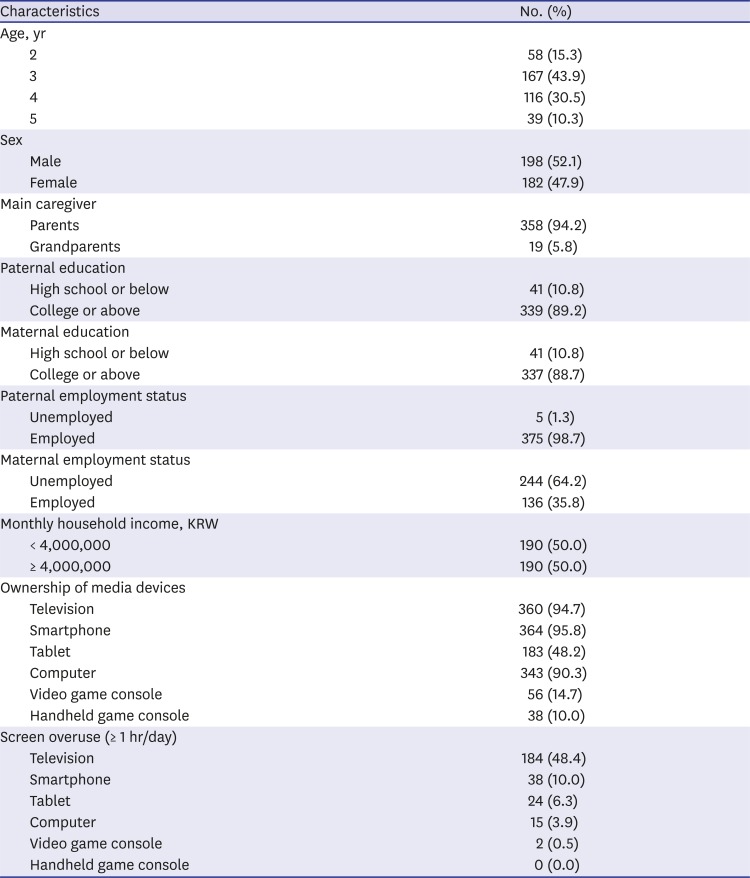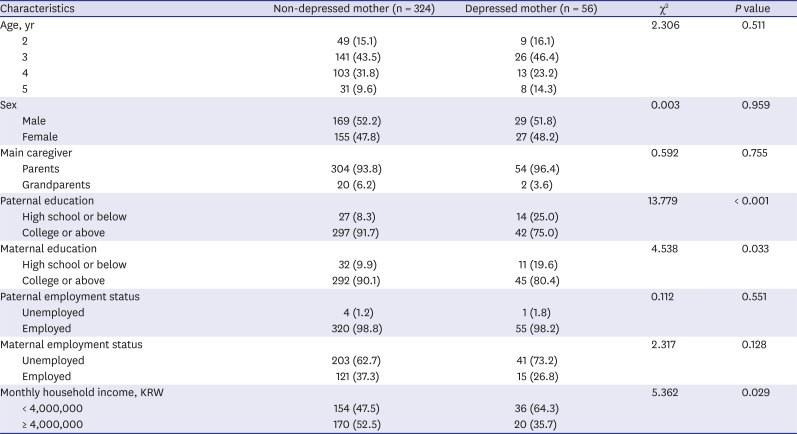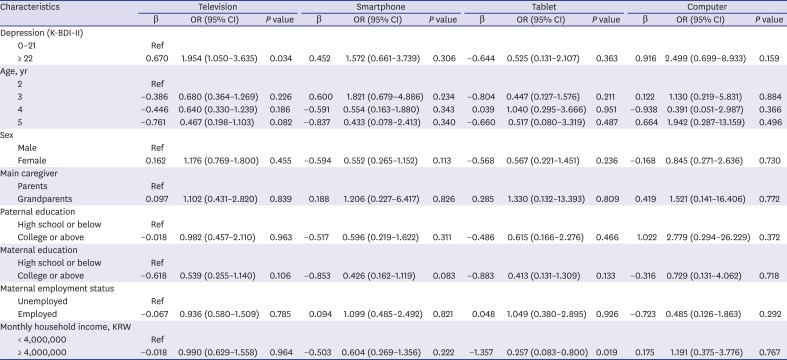1. Christakis DA, Ebel BE, Rivara FP, Zimmerman FJ. Television, video, and computer game usage in children under 11 years of age. J Pediatr. 2004; 145(5):652–656. PMID:
15520768.
2. Anand V, Downs SM, Bauer NS, Carroll AE. Prevalence of infant television viewing and maternal depression symptoms. J Dev Behav Pediatr. 2014; 35(3):216–224. PMID:
24633063.
3. Lee KS, Jung SJ, Kim MS. The Influence of Infants' (1–3 years) visual media overindulgence on their general, emotional and social development. Korean J Dev Psychol. 2015; 28(1):117–132.
4. Robinson TN, Wilde ML, Navracruz LC, Haydel KF, Varady A. Effects of reducing children's television and video game use on aggressive behavior: a randomized controlled trial. Arch Pediatr Adolesc Med. 2001; 155(1):17–23. PMID:
11177057.
5. Whang LS, Lee S, Chang G. Internet over-users' psychological profiles: a behavior sampling analysis on internet addiction. Cyberpsychol Behav. 2003; 6(2):143–150. PMID:
12804026.
6. Holloway D, Green L, Livingstone S. Zero to Eight: Young Children and Their Internet Use. London: EU Kids Online;2013.
7. Mistry KB, Minkovitz CS, Strobino DM, Borzekowski DL. Children's television exposure and behavioral and social outcomes at 5.5 years: does timing of exposure matter? Pediatrics. 2007; 120(4):762–769. PMID:
17908763.
8. ESRO Ltd. (GB). Ofcom Children's Media Lives - Year 3 Findings. London: ESRO Ltd.;2016.
9. Park H, Park M. Media use by families: correlations with intelligence, problem behavior, and family environments. Korean J Child Stud. 1998; 19(2):3–17.
10. Livingstone S, Görzig A, Ólafsson K. Disadvantaged Children and Online Risk. London: EU Kids Online;2011.
11. Council on Communications and Media. Media and young minds. Pediatrics. 2016; 138(5):e20162591. PMID:
27940793.
12. Terras MM, Ramsay J. Family digital literacy practices and children's mobile phone use. Front Psychol. 2016; 7:1957. PMID:
28066284.
13. Marsh J, Plowman L, Yamada-Rice D, Bishop JC, Lahmar J, Scott F, et al. Exploring Play and Creativity in Pre-Schoolers' Use of Apps: Final Project Report. place unknown: Technology and Play;2015.
14. Lovejoy MC, Graczyk PA, O'Hare E, Neuman G. Maternal depression and parenting behavior: a meta-analytic review. Clin Psychol Rev. 2000; 20(5):561–592. PMID:
10860167.
15. Murray L, Cooper P. Effects of postnatal depression on infant development. Arch Dis Child. 1997; 77(2):99–101. PMID:
9301345.
16. Weissman MM, Warner V, Wickramaratne P, Moreau D, Olfson M. Offspring of depressed parents: 10 years later. Arch Gen Psychiatry. 1997; 54(10):932–940. PMID:
9337774.
17. Weissman MM, Gammon GD, John K, Merikangas KR, Warner V, Prusoff BA, et al. Children of depressed parents. Increased psychopathology and early onset of major depression. Arch Gen Psychiatry. 1987; 44(10):847–853. PMID:
3662741.
18. Thompson DA, Christakis DA. The association of maternal mental distress with television viewing in children under 3 years old. Ambul Pediatr. 2007; 7(1):32–37. PMID:
17261480.
19. Roh D, Bhang SY, Choi JS, Kweon YS, Lee SK, Potenza MN. The validation of Implicit Association Test measures for smartphone and Internet addiction in at-risk children and adolescents. J Behav Addict. 2018; 7(1):79–87. PMID:
29383939.
20. Lee SY, Lee HK, Jeong H, Yim HW, Bhang SY, Jo SJ, et al. The hierarchical implications of internet gaming disorder criteria: which indicate more severe pathology? Psychiatry Investig. 2017; 14(3):249–259.
21. Sung HM, Kim JB, Park YN, Bai DS, Lee SH, Ahn HN. A study on the reliability and the validity of Korean version of the Beck Depression Inventory-II (BDI-II). J Korean Soc Biol Ther Psychiatry. 2008; 14(2):201–212.
22. Statistics Korea. Household Income & Expenditure Trends in 2015. Daejeon: Statistics Korea;2015.
23. Burdette HL, Whitaker RC, Kahn RS, Harvey-Berino J. Association of maternal obesity and depressive symptoms with television-viewing time in low-income preschool children. Arch Pediatr Adolesc Med. 2003; 157(9):894–899. PMID:
12963595.
24. Lauricella AR, Wartella E, Rideout VJ. Young children's screen time: the complex role of parent and child factors. J Appl Dev Psychol. 2015; 36:11–17.
25. Hamer M, Stamatakis E, Mishra GD. Television- and screen-based activity and mental well-being in adults. Am J Prev Med. 2010; 38(4):375–380. PMID:
20307805.
26. Potts R, Sanchez D. Television viewing and depression: no news is good news. J Broadcast Electron Media. 1994; 38(1):79–90.
27. Bank AM, Barr R, Calvert SL, Parrott WG, McDonough SC, Rosenblum K. Maternal depression and family media use: a questionnaire and diary analysis. J Child Fam Stud. 2012; 21(2):208–216. PMID:
22745524.
28. Cummings EM, Keller PS, Davies PT. Towards a family process model of maternal and paternal depressive symptoms: exploring multiple relations with child and family functioning. J Child Psychol Psychiatry. 2005; 46(5):479–489. PMID:
15845128.
29. Foster CE, Webster MC, Weissman MM, Pilowsky DJ, Wickramaratne PJ, Rush AJ, et al. Course and severity of maternal depression: associations with family functioning and child adjustment. J Youth Adolesc. 2008; 37(8):906–916. PMID:
25013241.
30. Howe AS, Heath AM, Lawrence J, Galland BC, Gray AR, Taylor BJ, et al. Parenting style and family type, but not child temperament, are associated with television viewing time in children at two years of age. PLoS One. 2017; 12(12):e0188558. PMID:
29261676.
31. Baumrind D. Effects of authoritative parental control on child behavior. Child Dev. 1966; 37(4):887–907.
32. Pelaez M, Field T, Pickens JN, Hart S. Disengaged and authoritarian parenting behavior of depressed mothers with their toddlers. Infant Behav Dev. 2008; 31(1):145–148. PMID:
17651806.
33. Chang FC, Chiu CH, Miao NF, Chen PH, Lee CM, Chiang JT, et al. The relationship between parental mediation and internet addiction among adolescents, and the association with cyberbullying and depression. Compr Psychiatry. 2015; 57:21–28. PMID:
25487108.
34. Tolar TD, Lederberg AR, Gokhale S, Tomasello M. The development of the ability to recognize the meaning of iconic signs. J Deaf Stud Deaf Educ. 2008; 13(2):225–240. PMID:
17827446.
35. Anderson DR, Pempek TA. Television and very young children. Am Behav Sci. 2005; 48(5):505–522.
36. Rideout V. Zero to Eight: Children's Media Use in America 2013: a Common Sense Media Research Study. San Francisco, CA: Common Sense Media;2013.
37. Anderson DR, Field DE, Collins PA, Lorch EP, Nathan JG. Estimates of young children's time with television: a methodological comparison of parent reports with time-lapse video home observation. Child Dev. 1985; 56(5):1345–1357. PMID:
4053746.
38. Hinkley T, Verbestel V, Ahrens W, Lissner L, Molnár D, Moreno LA, et al. Early childhood electronic media use as a predictor of poorer well-being: a prospective cohort study. JAMA Pediatr. 2014; 168(5):485–492. PMID:
24639016.
39. Christakis DA, Zimmerman FJ, DiGiuseppe DL, McCarty CA. Early television exposure and subsequent attentional problems in children. Pediatrics. 2004; 113(4):708–713. PMID:
15060216.
40. Certain LK, Kahn RS. Prevalence, correlates, and trajectory of television viewing among infants and toddlers. Pediatrics. 2002; 109(4):634–642. PMID:
11927708.







 PDF
PDF Citation
Citation Print
Print




 XML Download
XML Download